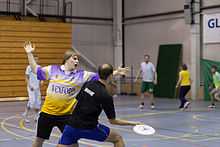Ultimate (sport)
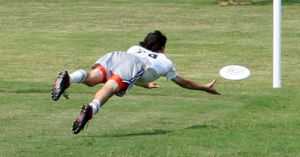 | |
| Highest governing body | World Flying Disc Federation |
|---|---|
| Nicknames | Ultimate Frisbee, flatball, or frisbee |
| Characteristics | |
| Team members |
grass: 7 per team. Beach: 5 per team (sometimes fewer or more) |
| Mixed gender | In some competitions and most leagues |
| Equipment | flying disc (frisbee) |
| Presence | |
| Olympic | No, but is included in World Games, also recognized by the International Olympic Committee (IOC) [1] |
Ultimate is a limited-contact team field sport played with a flying disc (frisbee). Points are scored by passing the disc to a teammate in the opposing end zone. Other basic rules imply that players must not take steps while holding the disc (that is, a player holding the disc must maintain a pivot), and interceptions and incomplete passes are turnovers. Rain, wind, or occasionally other adversities can make for a testing match; with rapid turnovers, heightening the pressure of play. A prominent feature of the modern game is the "lay out," a horizontal dive to catch or block the disc.[2]
From its beginnings in the American counterculture of the late 1960s, ultimate has resisted empowering any referee with rule enforcement, instead relying on the sportsmanship of players and invoking the "spirit of the game" to maintain fair play. Players call their own fouls and dispute a foul only when they genuinely believe it did not occur. Playing without referees is the norm for league play, but has been supplanted in club competition by the use of "observers"/"advisers" to help in disputes, and the nascent professional leagues even employ empowered referees.
In 2012 there were 5.1 million ultimate players in the United States.[3] Ultimate is played across the world in pickup games and by recreational, school, club, and national teams at various age levels and with open, women's, and mixed tournaments. In 2013, two professional leagues were operating in North America. The 13th biennial national team World Championships were held in Sakai, Japan in July, 2012. The United States won in the open and women masters' divisions, Japan won the women's tournament, Canada took the mixed and male masters' titles.[4]
"I just remember one time running for a pass and leaping up in the air and just feeling the Frisbee making it into my hand and feeling the perfect synchrony and the joy of the moment, and as I landed I said to myself, 'This is the ultimate game. This is the ultimate game.'" (Jared Kass, one of the inventors of ultimate, interviewed in 2003, speaking of the summer of 1968).[5]
Rules
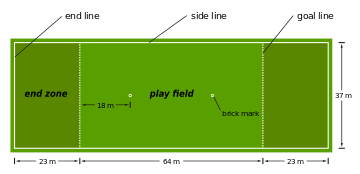
The two teams begin at opposite end zones and try to advance the disc to the other end zone. One team pulls to the other team, which is the starting throw to the game. Once in play, the disc may be moved only by passing, so the player holding the disc must stay put (must pivot one foot, but can move the rest of his body as he wishes while the static leg bottom holds the ground all the time). If a team successfully advances the disc into the end zone, that team scores a point, the teams swap directions, and the team that scored pulls to the other team.
If a pass is incomplete, intercepted, or caught out of bounds, the opposing team immediately gains possession and tries to move the disc in the other direction. Another way to change possession is that the player holding the disc, called the thrower, has a limited time to throw the disc: A defensive player within 10 feet of the thrower may loudly count to 10 (unless counted by the referee), and if the disc is not thrown within 10 seconds, the defense immediately gains possession. This defensive player is called the mark, and the audible count is called the stall count.
Under the professional rules, there are four 10-minute quarters. At the end of four quarters, whoever has the most goals wins. If there is a tie at the end of four quarters, an additional 5-minute overtime (OT) period is played. If there is a still a tie after the OT period, one point is played and whoever scores wins.
The club game is typically played until an end condition is reached, typically a time limit or when one team reaches a certain number of points.
A club regulation game features teams of 7 players each, with substitutions allowed between points and during injuries. A USA Ultimate regulation field is 120 yards (110m) by 40 yards (37m), including end zones each 25 yards (23m) deep.[6] In USA Ultimate Club Championship Series (2012) the endzone length was shortened to 20 yards (18m) to allow for consistency with WFDF rules used in international competition and to increase the number of field sites that can be used for ultimate.[7]
Several types of fouls exist. A throwing foul can be called when there is non-incidental contact between the thrower and the marker. When the disc is in the thrower's possession it is considered to be part of the thrower. There are even fouls for when a player is attempting to catch or receive the disc. For example when a player makes contact with the opponent while the disc is in the air and interferes with the opponent attempting to make a play on the disc, then said player has committed a receiving foul. A foul can be called when a defensive player is attempting to block a throw. When a defensive player initiates contact with the disc after an offensive player has gained possession of the disc, and the offensive player as a result loses possession of the disc, this is considered to be a "strip".[8]
Invention and early history
Team flying disc games using pie tins and cake pan lids were part of Amherst College student culture for decades before plastic discs were available. A similar two-hand touch football-based game was played at Kenyon College in Ohio starting in 1942.[5]
From 1965 or 1966 Jared Kass and fellow Amherst students Bob Fein, Richard Jacobson, Robert Marblestone, Steve Ward, Fred Hoxie, Gordon Murray, and others evolved a team frisbee game based on concepts from American football, basketball, and soccer. This game had some of the basics of modern ultimate including scoring by passing over a goal line, advancing the disc by passing, no travelling with the disc, and turnovers on interception or incomplete pass. Jared, an instructor and dorm advisor, taught this game to high school student Joel Silver during the summer of 1967 or 1968 at Mount Hermon Prep school summer camp.[5][9]
Joel Silver, along with fellow students Jonny Hines, Buzzy Hellring, and others, developed ultimate beginning in 1968 at Columbia High School, Maplewood, New Jersey, USA (CHS). The first sanctioned game was played at CHS in 1968 between the student council and the student newspaper staff. Beginning the following year evening games were played in the glow of mercury-vapor lights on the school's parking lot. Initially players of ultimate frisbee (as it was known at the time) used a "Master" disc marketed by Wham-O, based on Fred Morrison's inspired "Pluto Platter" design. Hellring, Silver, and Hines developed the first and second edition of "Rules of Ultimate Frisbee". In 1970 CHS defeated Milburn High 43-10 in the first interscholastic ultimate game. CHS, Milburn, and three other New Jersey high schools made up the first conference of Ultimate teams beginning in 1971.[5][9][10][11][12][13]
Alumni of that first league took the game to their colleges and universities. Rutgers defeated Princeton 29-27 in 1972 in the first intercollegiate game. This game was played exactly 103 years after the first intercollegiate American football game by the same teams at precisely the same site, which had been paved as a parking lot in the interim. Rutgers won both games by an identical margin.[10]
Rutgers also won the first ultimate frisbee tournament in 1975, hosted by Yale, with 8 college teams participating. That summer ultimate was introduced at the Second World Frisbee Championships at the Rose Bowl. This event introduced ultimate on the west coast of the USA.[10]
In 1975, ultimate was introduced at the Canadian Open Frisbee Championships in Toronto as a showcase event. Ultimate League play in Canada began in Toronto in 1979.[14][15]
In January 1977 Wham-O introduced the World Class "80 Mold" 165 gram frisbee. This disc quickly replaced the relatively light and flimsy Master frisbee with much improved stability and consistency of throws even in windy conditions. Throws like the flick and hammer were possible with greater control and accuracy with this sturdier disc. The 80 Mold was used in ultimate tournaments even after it was discontinued in 1983.[16]
Discraft introduced the Ultrastar 175 g disc in 1981, with an updated mold in 1983. This disc was adopted as the standard for ultimate during the '80s, with Wham-O holdouts frustrated by the discontinuation of the 80 mold and plastic quality problems with discs made on the replacement 80e mold. Wham-O soon introduced a contending 175 g disc, the U-Max, that also suffered from quality problems and was never widely popular for ultimate. In 1991 the Ultrastar was specified as the official disc for UPA tournament play and remains in wide use.[16][17][18]
The popularity of the sport spread quickly, taking hold as a free-spirited alternative to traditional organized sports. In recent years college ultimate has attracted a greater number of traditional athletes, raising the level of competition and athleticism and providing a challenge to its laid back, free-spirited roots.[19]
Players Associations
In late December 1979, the first national player-run ultimate organization was founded in the United States as the Ultimate Players Association (UPA). Tom Kennedy was elected its first director. Before the UPA, events had been sponsored by the International Frisbee Association (IFA), a promotional arm of Wham-O.[10]
The UPA organized regional tournaments and has crowned a national champion every year since 1979. Glassboro State College defeated the Santa Barbara Condors 19-18 at the first UPA Nationals in 1979.[10]
In 2010, the UPA rebranded itself as USA Ultimate.
The first European Championship tournament for national teams was held in 1980 in Paris. Finland won, with England and Sweden finishing second and third.[10] In 1981 the European Flying Disc Federation (EFDF) was formed.[10] In 1984 the World Flying Disc Federation was formed by the EFDF to be the international governing body for disc sports.[10] The first World Championships tournament was held in 1983 in Gothenburg, Sweden.
Ultimate Canada is the national governing body in Canada. The first Canadian National Ultimate Championships were held in Ottawa 1987.[20]
The European Ultimate Federation is the governing body for the sport of Ultimate in Europe. Funded in 2009, it is part of the European Flying Disc Federation (EFDF) and of the World Flying Disc Federation.
In 2006 ultimate became a BUCS accredited sport at UK universities for both indoor and outdoor open division events.
Strategy and Tactics
Offense
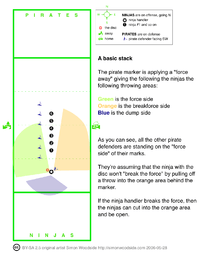
Players employ many different offensive strategies with different goals. Most basic strategies are an attempt to create open lanes on the field for the exchange of the disc between the thrower and the receiver. Organized teams assign positions to the players based on their specific strengths. Designated throwers are called handlers and designated receivers are called cutters. The amount of autonomy or overlap between these positions depends on the make-up of the team.
Vertical stack
One of the most common offensive strategies is the vertical stack. In this strategy, the offense lines up in a straight line along the length of the field. From this position, players in the stack make cuts (sudden sprints out of the stack) towards or away from the handler in an attempt to get open and receive the disc. The stack generally lines up in the middle of the field, thereby opening up two lanes along the sidelines for cuts, although a captain may occasionally call for the stack to line up closer to one sideline, leaving open just one larger cutting lane on the other side.
Horizontal Stack
Another popular offensive strategy is the horizontal stack. In the most popular form of this offense, three handlers line up across the width of the field with four cutters upfield, spaced evenly across the field. This formation encourages cutters to attack any of the space either upfield or downfield of the stack, granting each cutter access to the full width of the field and thereby allowing a degree more creativity than is possible with a vertical stack. If cutters cannot get open, the handlers swing the disc side to side to reset the stall count and in an attempt to get the defense out of position.
Feature
A variation on the horizontal stack offense is called a feature, or German. In this offensive strategy three of the cutters line up deeper than usual (this can vary from 5 yards farther downfield to at the endzone) while the remaining cutter lines up closer to the handlers. This closest cutter is known as the "feature", or "German." The idea behind this strategy is that it opens up space for the feature to cut, and at the same time it allows handlers to focus all of their attention on only one cutter. This maximizes the ability for give-and-go strategies between the feature and the handlers. It is also an excellent strategy if one cutter is superior to other cutters, or if he is guarded by someone slower than him. While the main focus is on the handlers and the feature, the remaining three cutters can be used if the feature cannot get open, if there is an open deep look, or for a continuation throw from the feature itself. Typically, however, these three remaining cutters do all they can to get out of the feature's way.
Spread
A third common offensive strategy is the spread, or split stack. The spread offense features three handlers in the same formation as for a horizontal stack, and four downfield cutters. Cutters split into two-person teams near both sidelines at the same distance from the handlers as in the horizontal stack. The first cut can come from either sideline, then usually moves into the center of the field before moving upfield or downfield. The second cut can also come from either sideline, and will usually cut in the opposite direction (downfield or upfield) as the first cut. The spread strategy creates a large lane in the middle of the field in which the active cutter is looking to make one big play in or out before clearing back to one of the sidelines.
Hybrid
A fourth, less common strategy is called the hybrid, because it creates two-person teams of cutters just as in the split stack, but one of these two-person teams plays as a vertical stack on one side of the field. Handlers arrange themselves as in a horizontal stack. The advantage of the hybrid is that one of the two-person teams makes use of the large open lane created in the middle of the field just as in the split stack offense, while the other two-person team has one person ready to make a continuation cut and one person ready to make an additional cut to the handlers.
Tri-Force
Finally there is a fifth strategy known as the tri-force, trinity play, or triad, which breaks up the team into two teams of three and one option. Each team of three stays on opposite sides of the field. When the disc is being handled on their side of the field the two receivers make a series of tight cuts around the handler quickly moving the disc up the field in short increments. The other team of three stays on the opposite side of the field and slightly behind leaving them open for a dump while also clearing out the majority of the field for the option. The option needs to be the fastest player on the team because his or her job is to make deep cuts switching between a huck and dump option. The tri-force requires every player to be a competent handler and runner, but can be difficult to stop once it builds momentum.
Many teams are developing a wildcat offense based on the American and Canadian football setup. The formation is a variation of a traditional horizontal stack, but involves exploiting mismatches by forcing play in the direction of the mismatch to create space for that person to make a deep cut for an easy point. The disc starts in the middle of the field, and the dump cut lines up as though to take a "handoff" (a quick dump.) this gives a number of options to the primary handler, including the fake dump to down field huck.
Many advanced teams develop variations on the basic offenses to take advantage of the strengths of specific players. Frequently, these offenses are meant to isolate a few key players in one-on-one situations, allowing them more freedom of movement and the ability to make most of the plays, while the others play a supporting role.
In all of these strategies, players making cuts have two major options in how they cut. They may cut in towards the disc and attempt to find an open avenue between defenders for a short pass, or they may cut away from the disc towards the deep field. The deep field is usually sparsely defended but requires the handler to throw a huck (a long downfield throw).
Defense
Force
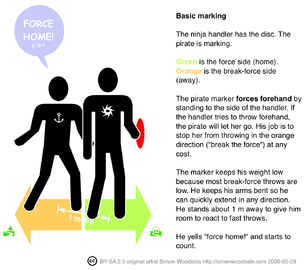
One of the most basic defensive principles is the force. The marker effectively blocks the handler's access to half of the field, by aggressively blocking only one side of the handler and leaving the other side open. The unguarded side is called the force side because the thrower is generally forced to throw to that side of the field. The guarded side is called the break-force side, or simply break side, because the thrower would have to "break" the force to throw to that side. This is done because, assuming evenly matched players, the handler is considered to have an advantage over the marker. It is considered to be relatively easy for the handler to fake out or outmaneuver a marker who is trying to block the whole field, and thus be able to throw the disc. Alternatively, it is generally possible to effectively block half of the field.
The marker calls out the force side ("force home" or "force away") before starting the stall count in order to alert the other defenders to which side of the field is open to the handler. The team can choose the force side ahead of time, or change it on the fly from throw to throw. Aside from forcing home or away, other forces are "force sideline" (force towards the closest sideline), and force "middle" (force towards the center of the field). Another common tactic is to "force forehand" (force the thrower to use their forehand throw) since most players, especially at lower levels of play, have a stronger backhand throw. "Force flick" refers to the forehand; "force backhand" refers to the backhand.
When the marker calls out the force side, the team can then rely on the marker to block off half the field and position themselves to aggressively cover just the open/force side. If they are playing one-to-one defense, they should position themselves on the force side of their marks, since that is the side that they are most likely to cut to.
Another type of force is the "straight-up" mark (also called the "no-huck" mark). In this defense, the player marking the handler positions himself directly between the handler and the end zone and actively tries to block both forehands and backhands. Although the handler can make throws to either side, this is the best defense against long throws ("hucks") to the center of the field.
One-on-one Defense
The simplest defensive strategy is the one-on-one defense (also known as "man-to-man", "man" or simply "person"), where each defender guards a specific offensive player, called their "mark". The one-on-one defense emphasizes speed, stamina, and individual positioning and reading of the field. Often players will mark the same person throughout the game, giving them an opportunity to pick up on their opponent's strengths and weaknesses as they play. One-on-one defense can also play a part role in other more complex zone defense strategies. One-on-one defense involves shifting your hips to match your opponents. It is critical to leave a cushion between yourself and the player you are marking. If a person can shuffle and stay with the person they are marking, then they are doing a good job as a defender. Their person should never even be an option on the field.
Zone defense
With a zone defense strategy, the defenders cover an area rather than a specific person. The area they cover moves with the disc as it progresses down the field. Zone defense is frequently used when the offence plays horizontal stack, or when the weather is windy, rainy, or snowy. The zone defense is also used to discourage the offense from making long passes. A zone defense usually has two components. The first is a group of - usually three - players close to the disc who attempt to contain the offenses' ability to pass and prevent forward movement, At least one defender towards the end zone to block any long shots to score, and the rest defend around the middle of the field.
The "zone" is sometimes called the "wedge", "cup", "wall", or "clam" (depending on the specific play or type of zone defense). These close defenders always position themselves relative to the disc, meaning that they have to move quickly as it passes from handler to handler.
Wedge
The wedge is a configuration of two close defenders. One of them marks the handler with a force, and the other stands away and to the force side of the handler, blocking any throw or cut on that side. The wedge allows more defenders to play up the field but does little to prevent cross-field passes.
Cup
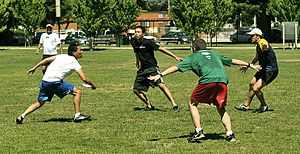
The cup involves three players, arranged in a semi-circular cup-shaped formation, one in the middle and back, the other two on the sides and forward. One of the side players marks the handler with a force, while the other two guard the open side. Therefore the handler will normally have to throw into the cup, allowing the defenders to more easily make blocks. With a cup, usually the center cup blocks the up-field lane to cutters, while the side cup blocks the cross-field swing pass to other handlers. The center cup usually also has the responsibility to call out which of the two sides should mark the thrower, usually the defender closest to the sideline of the field. The idea of the cup is to force the offense into making many short passes behind and around the cup. The more times the offense is forced to throw the greater the chance that the handlers will make a bad throw, or a defender will intercept the disc. The other four defenders traditionally play as two wings, who each cover a sideline, a middle sometimes referred to as a "middle-mid", "popper d", or "mid-deep" who covers directly behind the cup for any short throws through or over the cup, and a deep, who covers any long throws by out of order the offense.
Wall
The "wall" sometimes referred to as the "1-3-3" involves four players in the close defense. One player is the marker, also called the "rabbit", "chaser" or "puke" because they often have to run quickly between multiple handlers spread out across the field. The other three defenders form a horizontal "wall" or line across the field in front of the handler to stop throws to short in-cuts and prevent forward progress. The players in the second group of a zone defense, called "mids" and "deeps", position themselves further out to stop throws that escape the cup and fly upfield. Because a zone defense focuses defenders on stopping short passes, it leaves a large portion of the field to be covered by the remaining mid and deep players. Assuming that there are seven players on the field, and that a cup is in effect, this leaves four players to cover the rest of the field. In fact, usually only one deep player is used to cover hucks (the "deep-deep"), with two others defending the sidelines and possibly a single "mid-mid". A variation of the 1-3-3 is to have two markers: The "rabbit" marks in the middle third and strike side third of the field. The goal is for the "rabbit" to trap the thrower and collapse a cup around him. If the rabbit is broken for large horizontal yardage, or if the disc reaches the break side third of the field, the break side defender of the front wall marks the throw. In this variation the force is directed one way. This variation plays to the strength of a superior marking "rabbit".
Alternately, the mids and deeps can play a one-to-one defense on the players who are outside of the cup or cutting deep, although frequent switching might be necessary.
Electric Slide
The electric slide is wedge defense with the "wall" of a wall defense, also called a "2-4-1". In the electric slide, two players are up on the handlers. One player will mark the offensive player with the disc while the other player covers the dump. When the handler with the disc does dump, the two defensive players slide over to cover them in the same way. If the mark forces, the other defender only has to guard the dump on the side his teammate is forcing. The other players set up like a wall defense, with four players lined up across the field stopping cutters and one player to cover deep throws. This player in the back can call out cuts to the four in the wall to help them.
This defense works very well with forcing as long as the mark cannot be broken. But, this does give the offensive handler the opportunity to throw deep. If the offense is constantly completing long throws, the defense can adjust and move one person back in the wall to join the person covering deep; also called a "2-3-2".
Junk defense
A junk defense is a defense using elements of both zone and man defenses; the most well-known is the "clam" or "chrome wall". In clam defenses, defenders cover cutting lanes rather than zones of the field or individual players. The clam can be used by several players on a team while the rest are running a man defense. Typically, a few defenders play man on the throwers while the cutter defenders play as "flats", taking away in cuts by guarding their respective areas, or as the "deep" or "monster", taking away any deep throws.
Eric "the Oven-Mitt Mauler" Warm of the Towson University Ultimate Club, circa 2000 created a gimmick zone aimed at turning over in-bounds plays from the sideline. This was called the "Iron Fist," and led to whole tournaments worth of word-play and innuendo.
This defensive strategy is often referred to as "bait and switch". In this case, when the two players the defenders are covering are standing close to each other in the stack, one defender will move over to shade them deep, and the other will move slightly more towards the thrower. When one of the receivers makes a deep cut, the first defender picks them up, and if one makes an in-cut, the second defender covers them. The defenders communicate and switch their marks if their respective charges change their cuts from in to deep, or vice versa. The clam can also be used by the entire team, with different defenders covering in cuts, deep cuts, break side cuts, and dump cuts.
The term "junk defense" is also often used to refer to zone defenses in general (or to zone defense applied by the defending team momentarily, before switching to a man defense), especially by members of the attacking team before they have determined which exact type of zone defense they are facing.
Spirit of the Game

Although professional ultimate uses a refereed system in the USA, club ultimate is known for its “Spirit of the Game”, often abbreviated SOTG. Club ultimate's self-officiated nature demands a strong spirit of sportsmanship and respect.
In Europe and other countries, even professional play does not have referees. Some world championship games have had no referees, and disputes were decided by the players themselves.
The following description is from the official rules established by USA Ultimate:
Ultimate has traditionally relied upon a spirit of sportsmanship which places the responsibility for fair play on the player. Highly competitive play is encouraged, but never at the expense of the bond of mutual respect between players, adherence to the agreed upon rules of the game, or the basic joy of play. Protection of these vital elements serves to eliminate adverse conduct from the ultimate field. Such actions as taunting of opposing players, dangerous aggression, intentional fouling, or other ‘win-at-all-costs’ behavior are contrary to the spirit of the game and must be avoided by all players.
Many tournaments give awards for the most spirited team, as voted for by all the teams taking part in the tournament.
While "spirit of the game" is a general attitude, Ultimate has an agreed upon procedure to deal with unclear or disputed situations [21]
Competition
Pick-up games
There are many types of pick-up. Often this consists of tournaments played outside the championship circuit, including hat tournaments, in which teams are selected on the day of play by picking names out of a hat. These are generally held over a weekend, affording players several games during the day as well as the chance to socialize at night. Pick-up leagues also exist, hosting weekly pick-up games that may be played on arbitrary week nights. In addition, less formal games of pick-up are frequent in parks and fields across the globe.
Hat tournaments
Hat tournaments are common in the ultimate circuit. At these tournaments players join individually rather than as a team. The tournament organizers form teams by randomly taking the names of the participants from a hat.
Many hat tournaments on the US west coast have a "Hat Rule" requiring all players to wear a hat at all times during play. If a player gains possession of the disc, yet loses his hat in the process, the play is considered a turnover and possession of the disc reverts to the other team.
However, in some tournaments, the organizers do not actually use a hat, but form teams while taking into account skill, experience, sex, age, height, and fitness level of the players in the attempt to form teams of even strength. Many times the random element remains, so that organizers randomly pick players from each level for each team, combining a lottery with skill matching. Usually, the player provides this information when he or she signs up to enter the tournament. There are also many cities that run hat leagues, structured like a hat tournament, but where the group of players stay together over the course of a season.
Large tournaments are often organized with pool play on the first day and championship play on the second day. Teams in the lower half of play compete for the championship.
Current leagues
Regulation play, sanctioned in the United States by the USA Ultimate, occurs at the college (open & women's divisions), club (open, women's, mixed (co-ed), masters and grandmasters divisions) and youth (boys & girls divisions) levels, with annual championships in all divisions. Top teams from the championship series compete in semi-annual world championships regulated by the WFDF (alternating between Club Championships and National Championships), made up of national flying disc organizations and federations from about 50 countries.

Ultimate Canada is the governing body for the sport of ultimate in Canada.[22] Beginning in 1993, the goals of Ultimate Canada include representing the interests of the sport and all ultimate players, as well as promoting its growth and development throughout Canada. Ultimate Canada also facilitates open and continuous communication within the ultimate community and within the sports community and to organize ongoing activities for the sport including national competitions and educational programs.
Founded in 1986, incorporated in 1993, the Ottawa-Carleton Ultimate Association based in Ottawa, Ontario, Canada, claims to have the largest summer league in the world with 354 teams and over 5000 players as of 2004.[23]
The Toronto Ultimate Club,[24] founded in 1980 by Ken Westerfield and Chris Lowcock, based in Toronto Canada, has 3300 members and 250 teams, playing year round.[25]
The Los Angeles Organization of Ultimate Teams puts on annual tournaments with thousands of players.
There have been a small number of children's leagues. The largest and first known pre-high school league was started in 1993 by Mary Lowry, Joe Bisignano, and Jeff Jorgenson in Seattle, Washington.[26] In 2005, the discNW Middle School Spring League had over 450 players on 30 mixed teams. Large high school leagues are also becoming common. The largest one is the discNW High School Spring League. It has both mixed and single gender divisions with over 30 teams total. The largest adult league is the San Francisco Ultimate League, with 350 teams and over 4000 active members in 2005, located in San Francisco, California. The largest per capita is the Madison Ultimate Frisbee association, with an estimated 1.8% of the population of Madison, WI playing in active leagues. Dating back to 1977, the Mercer County (New Jersey) Ultimate Disc League (www.mercerultimate.org) is the world's oldest recreational league. There are even large leagues with children as young as third grade, an example being the junior division of the SULA ultimate league in Amherst, Massachusetts.
High school and junior leagues
Tournaments at the high school level of play range from tournaments hosted by local teams to tournaments at a national level. USA Ultimate hosts the Men and Women's HS national championships every year in Blaine, Minnesota. This tournament is known as Youth Club Championships, or YCC's, and often features at-large teams (different players from within a large area such as New England), no single high school team attends.
The most prestigious tournaments for high school teams in the United States splits the championships between the Northeast, Southern, Central and West Coast. The tournaments are known as Northeastern's, Southern's, Centrals and Western's and are becoming more competitive as high school programs are beginning to treat the game of ultimate more seriously. USA Ultimate also hosts a national Junior's club team tournament and sends a representative team to the World Junior Ultimate Championships, held every two years. At a lower level, USA Ultimate has also sanctioned organized statewide tournaments in 20 states.
In the United Kingdom, UK Ultimate has organized Junior's indoor and outdoor Nationals since the mid-'90's, with a women's division since 2005.
College teams
There are over 12,000 student athletes playing on over 700 college ultimate teams in North America,[27] and the number of teams is steadily growing. Separated into Open (nearly 450 teams) and Women's (around 200 teams) Divisions, teams compete in the USA Ultimate College Championship series during the spring. The series consists of 3 tournaments: conferences, regionals, and nationals. Each year, the top teams from conferences move on to regionals. The regional champion, and possibly a number of strength bids, advance to Nationals to compete for the championship title in May. College teams have for years been trying to get the sport accepted to NCAA status, without success.
Ultimate Canada operates two competitions for university ultimate teams in Canada: the Canadian University Ultimate Championships (CUUC) and the Canadian Eastern University Ultimate Championships (CEUUC).[20]
Club teams
USA Ultimate Club Ultimate consists of Open, Women's, Masters, Youth and Mixed divisions. Club has regional championships and a national championship, and international competition.
World Ultimate Club Championships are quadrennial events organized by WFDF. The upcoming tournament is in Lecco, Italy in August 2014. The previous tournament was in Prague, Czech Republic in July 2010.
Professional leagues
The American Ultimate Disc League (AUDL) is one of two professional level ultimate leagues in the United States. It was founded by Josh Moore, and its inaugural season began in April, 2012. The league began with eight teams, but currently consists of 25 teams in 4 regionalized divisions. Each team plays a total of 16 regular season games on Saturdays and Sundays during the months of April through July. The team funding comes from sources similar to those of other professional sports: sales of tickets, merchandise, concessions and sponsorship.[28] In 2015, 14 games will be broadcast every Saturday on ESPN3 throughout the season.
Major League Ultimate (MLU) was formed in 2013 after the Philadelphia Spinners organization split from the AUDL. It comprises an Eastern and a Western Division and currently has 8 teams.[29]
Major tournaments
- World Games, international tournament attended by national teams; organized by the WFDF. 2009 tournament link.
- World Ultimate & Guts Championships, international tournament attended by national teams; organized by the WFDF. 2008 tournament link.
- World Ultimate Club Championships, international tournament attended by club teams; organized by the WFDF. 2014 tournament link.
- World Junior Ultimate Championships, international tournament attended by national junior teams; organized by the WFDF. 2014 tournament link.
- USA Ultimate Championship Series, an American and Canadian tournament series attended by regional teams; organized by USA Ultimate. Championship Series link.
- No Borders Ultimate Championships, Over fifty teams from across Canada compete annually. Hosted By the Ottawa Ultimate Club. 2014 tournament Link
- European Ultimate Championships, European tournament attended by national teams; organized by the EFDF. 2007 tournament link.
- European Ultimate Club Series, European tournament attended by club teams that qualify at the European Ultimate Championships in their region; organized by the EFDF. 2006 tournament link.
- European Ultimate Club Championships, European tournament attended by club teams every 4 years; organized by the EFDF.
- Spring Reign, an annual youth Ultimate Tournament held in Burlington, Wa. Organized by discNW, Spring Reign is the largest youth Ultimate tournament in the world. Spring Reign Website
- Chennai Heat, India's largest Beach Terrain Tournament, held in Chennai. It's the most competitive tournament in India.[30]
- BUO - Bangalore Ultimate Open - India's largest ultimate frisbee tournament on grass.
- Windmill Windup Amsterdam, the biggest annual tournament in Europe to date on grass with over 90 teams from all over the world. Known for its relaxed festival atmosphere and high-level ultimate. It is held annually in June, in Amsterdam, the Netherlands.
- Malaysia Ultimate Open, Malaysia's largest annual tournament, held in Kuala Lumpur. Hosts about 6 fields annually. http://www.ultimatemalaysia.com/
- North American Grand Masters Championships, Held annually in Montreal Canada in September.
- Manila Spirits held yearly in the Philippines around October–November
Beach Ultimate tournaments

- World Championship Beach Ultimate 2007,[31] the 2nd 5-on-5 Beach Ultimate World Championship for national teams. Held in December 2007 in Brazil. Organized by Federação Paulista de Disco[32] with the collaboration of BULA.
- European Championship Beach Ultimate[33] European tournament attended by national teams; organized by BULA.
- Paganello[34] unofficial Beach Ultimate club world cup, held every year on Easter weekend in Rimini, Italy.
- Yes BUT Nau[35] in Le Pouliguen, France, held every year on the Pentecost/Whit Monday holiday (May/June), organized by the Frisbeurs Nantais[36]
- Beach Cup,[37] Burla Beach Cup A large tournament, in 2006 hosted 70 teams, held every year in September in Viareggio, Tuscany, Italy. Organized by the Tuscan Flying Bish Association.[38]
- CUBE[39] Caledonia's Ultimate Beach Event. The University of Aberdeen's BULA affiliated open beach Ultimate competition held annually in April.
- Wildwood[40] the largest annual beach Ultimate tournament in the world[41] held in Wildwood, New Jersey.
- Sandblast,[42] an annual beach Ultimate tournament held in early July located in Chicago, Illinois.
- TBUF[43] the longest-running annual beach Ultimate tournament[44] in the world (since 1986) held in mid June located in Galveston, Texas.
- Lei-Out,[45] held in late January in Santa Monica, California.
- Flat Out,[46] held every November in Nelson, New Zealand since 2000.
- Beaches Be Crazy,[47] held every year at the beginning of September at Curracloe Beach, Co. Wexford, Ireland
- Boracay Ultimate Open,[48] held every April/May in Boracay Island, Philippines.
- Chennai Heat,[49] is India's 7-on-7 beach Ultimate tournament held every October in Chennai, Tamil Nadu, India.
- MonsterBall,[50] is a Dutch Beach Ultimate tournament held at the end of summer in Monster, South Holland, The Netherlands.
See also
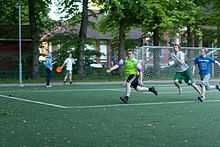
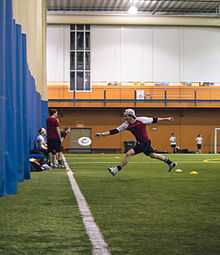
- American Ultimate Disc League
- Beach Ultimate Lovers Association
- Deutscher Frisbeesport-Verband
- Disc golf
- Disc throws
- Flying disc
- Flying disc freestyle
- Flying disc games
- Goaltimate
- Ken Westerfield
- List of Ultimate teams
- Major League Ultimate
- U.S. intercollegiate Ultimate champions
- USA Ultimate
- Ultimate Canada
- World Flying Disc Federation
- Ultimate in Japan
References
- ↑ "World Flying Disc Federation Receives Recognition by the International Olympic Committee". World Flying Disc Federation. 31 May 2013.
- ↑ Smith, Brodie (May 9, 2011). "How To Layout in Ultimate Frisbee". YouTube. BrodieSmithUltimate. Retrieved June 16, 2014.
- ↑ "Ultimate Frisbee Participation [SFIA]". Sludge Output. Retrieved 14 January 2014.
- ↑ "NTU: Tournament Summary". Hartti Suomela. Retrieved 1 March 2014.
- ↑ 5.0 5.1 5.2 5.3 Leonardo, Pasquale Anthony; Zagoria, Adam (2005). Ultimate: The First Four Decades. Joe Seidler. ISBN 0976449609. Retrieved 13 January 2014.
- ↑ "Rules of Ultimate". Usaultimate.org. 2010-08-01. Retrieved 2014-08-02.
- ↑
- ↑ "11th Edition Rules". Usaultimate.org. Retrieved 2014-08-02.
- ↑ 9.0 9.1 "Ultimate History - General". vimeo.com. Retrieved 2015-01-23.
- ↑ 10.0 10.1 10.2 10.3 10.4 10.5 10.6 10.7 "An Abbreviated History of Ultimate Compiled by Michael E. Iacovella". wfdf.org. Retrieved 2013-12-08.
- ↑ "Major Steps in History of Ultimate". wfdf.org. Retrieved 2013-12-08.
- ↑ "Timeline of early history of Flying Disc Play (1871-1995)". wfdf.org. Retrieved 2013-12-08.
- ↑ "History of the Frisbee". wfdf.org. Retrieved 2013-12-08.
- ↑ "TUC History". Toronto Ultimate Club History. Retrieved December 3, 2014.
- ↑ "Ultimate Canada". Ultimate Canada History History. Retrieved December 16, 2014.
- ↑ 16.0 16.1 "Special Merit: The "80 Mold"". usaultimate.org. Retrieved 2013-12-08.
- ↑ "The Discraft Ultrastar (Class of 2011)". usaultimate.org. Retrieved January 23, 2015.
- ↑ "When Wham-O Was King: Why The Innova V. Discraft Debate Is Old News". ultiworld.com. Retrieved January 23, 2015.
- ↑ Jordan Holtzman-Conston (2010). Countercultural Sports in America: The History and Meaning of Ultimate Frisbee. Waltham, Mass. Retrieved 5 December 2014.
- ↑ 20.0 20.1 "Ultimate Canada". Home Page. Retrieved May 15, 2013.
- ↑ "Basic Rules". Wfdf.org. Retrieved 2014-08-02.
- ↑ "Ultimate Canada". Home Page. Retrieved May 15, 2013.
- ↑ "Play Ultimate". Retrieved 1 May 2015.
- ↑ "Toronto Ultimate Club". Toronto Ultimate Home Page. Retrieved March 8, 2013.
- ↑ "TUC History". Toronto Ultimate Club History. Retrieved March 29, 2013.
- ↑ Bock, Paula (July 24, 2005). "The Sport Of Free Spirits". The Seattle Times Sunday Magazine (Seattle, Washington: The Seattle Times company). Retrieved 2008-08-28.
- ↑ USA Ultimate College Championships
- ↑ "Ultimate Interviews". Mark Earley. Retrieved 2012-04-15.
- ↑ "About Major League Ultimate". Retrieved 2012-11-29.
- ↑ "Chennai Heat homepage".
- ↑ "WCBU 2007 homepage".
- ↑ "frisbeebrasil.com.br".
- ↑ "Ecbu 2008".
- ↑ "Paganello homepage".
- ↑ "yes BUT Nau homepage".
- ↑ "Frisbeurs Nantais homepage".
- ↑ "Associazione Sportiva Dilettantistica BB-SEA" (in Italian). bb-sea.com. Retrieved 3 December 2010.
- ↑ "Tuscan Ultimate". Retrieved 3 December 2010.
- ↑ "?".
- ↑ "Wildwood Ultimate homepage".
- ↑ "With 400-plus teams in action at Wildwood Ultimate 2010, sand, Frisbees and bodies all go flying". pressofatlanticcity.com. Retrieved 3 December 2010.
- ↑ "Chicago Sandblast homepage".
- ↑ "Houston Ultimate - TBUF".
- ↑ "Houston Ultimage - TBUF".
- ↑ "Lei-Out homepage".
- ↑ "Flat Out homepage".
- ↑ "Beaches Be Crazy homepage".
- ↑ "Boracay Open 2012 on FFindr!".
- ↑ "Chennai Heat Home Page".
- ↑ "MonsterBall Homepage".
External links
| Wikimedia Commons has media related to Ultimate frisbee. |
Rules
- Professional Ultimate (AUDL)
- Professional Ultimate (MLU)
- WFDF rules (worldwide, except North America)
- The Complete 11th Edition of the Rules of Ultimate, Approved 01/11/2007 (Americas)
Spirit of the game
Hall of Fame
Leagues and associations
- American Ultimate Disc League (AUDL)
- Major League Ultimate (MLU)
- USA Ultimate (USAU) (formerly Ultimate Players Association (UPA))
- World Flying Disc Federation (WFDF)
- European Flying disc Federation (EFDF)
- Japan Flying Disc Association (JFDA)
- Ultimate Canada (UC) (formerly Canadian Ultimate Players Association (CUPA))
- Beach Ultimate Lovers Association (BULA)
- Finnish Ultimate / Finnish Flying Disc Association (FFDA)
- Hungarian Flying Disc Association (MFSZ)
- Irish Flying disc Association (IFDA)
- Italian Flying Disc Federation (FIFD)
- UK Ultimate association(UKUA)
- Pakistan Flying Disc Federation (PFDF) (formerly Frisbee Federation of Pakistan (FFP) Ultimate Frisbee Pakistan Association (UFPA))
- New Zealand Ultimate (NZU)
- Slovak Association of frisbee (SAF)
- Asociacion de Jugadores de Ultimate en Colombia(AJUC)
- Panama Ultimate
- Toronto Ultimate Club (TUC)
- Utah Ultimate Disc Association (UUDA)
- Vietnam Ultimate (HUC)
- Korea Ultimate Players Association (KUPA)
- Ultimate Players Association of India (UPAI)
Publications
Discussions
| ||||||||||||||||||||||||||||||||||||||||||||||||||||||||||||||
